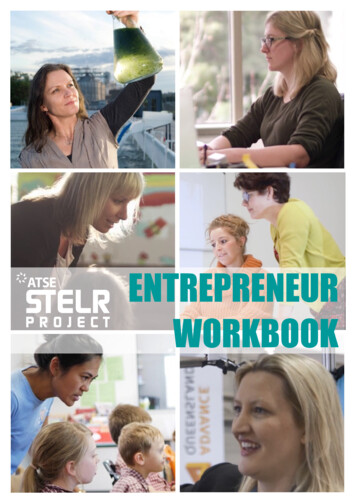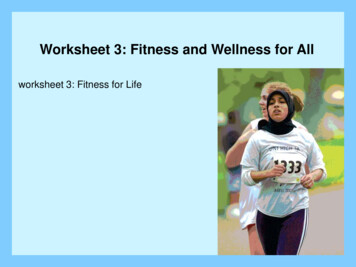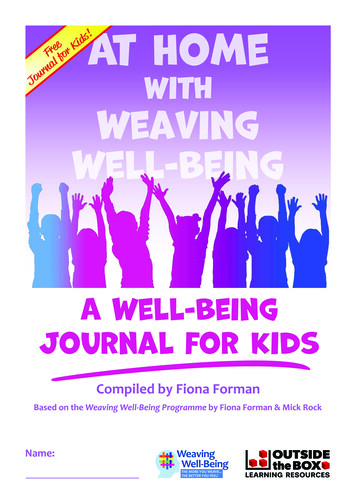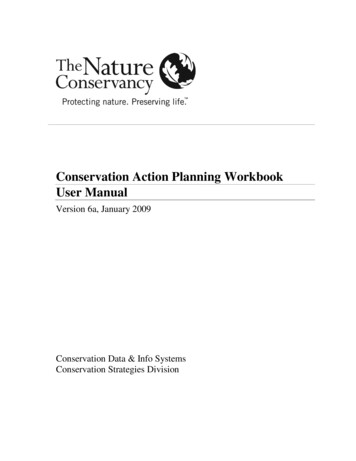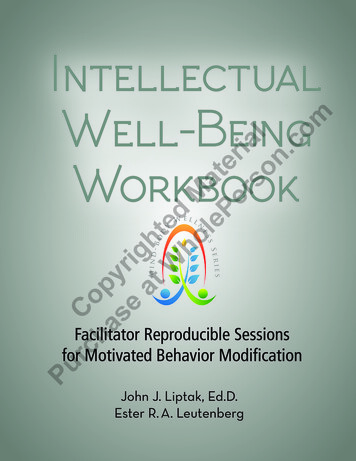
Transcription
IntroductionyWellneriess SdM i n d -Mindes-BonyWelleriess SBoesdrc Coha pse yriat ghW tedho Mle atPe errs ingWorkbookWorkbookFacilitator Reproducible Sessionsfor Motivated Behavior ModificationJohn J. Liptak, Ed.D.FacilitatorEsterReproducibleR.A. LeutenbergSessionsPufor Motivated Behavior ModificationJohn J. Liptak, Ed.D.Ester R. A. LeutenbergDuluth, Minnesota 2014 Whole Person Associates, 101 W. 2nd St., Suite 203, Duluth MN 55802 800-247-6789i
rc Coha pse yriat ghW tedho Mle atPe errs ialon.comIntellectual Well-BeingWhole Person101 W. 2nd St., Suite 203Duluth, MN son.comIntellectual Well-Being WorkbookFacilitator Reproducible Sessionsfor Motivated Behavior ModificationCopyright 2014 by John J. Liptak and Ester R. A. Leutenberg.All rights reserved. Except for short excerpts for review purposesand materials in the assessment, journaling activities, andeducational handouts sections, no part of this book may bereproduced or transmitted in any form by any means, electronicor mechanical without permission in writing from the publisher.Self-assessments, exercises, and educational handouts are meantto be photocopied.All efforts have been made to ensure accuracy of the informationcontained in this book as of the date published. The author(s)and the publisher expressly disclaim responsibility for anyadverse effects arising from the use or application of theinformation contained herein.Printed in the United States of AmericaPu10 9 8 7 6 5 4 3 2 1iiEditorial Director: Carlene SippolaArt Director: Joy Morgan DeyLibrary of Congress Control Number: 2014909584ISBN: 978-1-57025-316-4 2014 Whole Person Associates, 101 W. 2nd St., Suite 203, Duluth MN 55802 800-247-6789
IntroductionOur thanks to these professionals who make us look good!Art Director – Joy DeyEditor and Lifelong Teacher – Eileen RegenEditorial Director – Carlene SippolaProofreader – Jay LeutenbergReviewer – Carol Butlerrc Coha pse yriat ghW tedho Mle atPe errs ialon.comIntroduction for the FacilitatorWhat is Intellectual Well-Being?Overall well-being and a life free from major sources of stress have many dimensions. Intellectual wellbeing is important to a sense of overall wellness. The intellectual dimension of wellness, although oftenoverlooked and undervalued, is extremely important in coping with stress and living a fulfilling life.Intellectual well-being can be difficult to describe, but it is essentially related to how interested your clientsare in learning new skills, expanding their knowledge, thinking critically, seeking out new and interestingchallenges, maintaining a sense of creativity and curiosity, searching for lifelong learning opportunitiesand stimulating mental activities, and being open to new ideas. If your clients are not exhibiting thesecharacteristics, they may need to develop more effective intellectual wellness habits. When clients begindeveloping intellectual well-being habits, they begin to exhibit greater participation in creative, scholastic,cultural and community-based activities.The Intellectual Well-Being Workbook is designed to help your clients enhance existing intellectual wellnesstraits and develop new attitudes that will improve their intellectual health. By completing the assessments,activities and exercises, you will help your clients to achieve the following Begin engaging in clear thinking and recall with minimal interference from emotional baggage Think independently rather than blindly going with the thinking of the crowd Think critically about local, community, national and international issues Use effective reasoning skills Maintain an open mind to new situations and novel approaches Develop and broaden understanding and acceptance of their cultural heritage Apply what they have learned at home or on a job Pick up easily on new concepts and ideas Develop an appreciation and enthusiasm for lifelong learning Develop an interest in engaging in intellectually stimulating activities throughout their lifespan Utilize their accumulated knowledge and experience for the greater good.PuLiving an intellectually healthy existence sounds easy, but is often very difficult to accomplish in everydaylife. Many people experience stress in their lives when they are faced with new situations, exposed topeople who are different from themselves, and frightened by new ideas and novel ways to approachsituations in their lives. Intellectually well people find that they are able to approach new ideas andsituations with enthusiasm and are not restricted to only that which has been done before. They arecreative and always looking for ways to improve themselves and their future. They are curious andapproach life with passionate desire to understand and embrace opportunities to learn new things. Theywill have the tools and techniques to cope with difficult life situations through being open-minded, ableto pick up on new ideas, and interested in improving themselves. The Intellectual Well-Being Workbook isdesigned to help your clients understand how the many ways intellectual well-being can reduce stress andenhance their overall life satisfaction. 2014 Whole Person Associates, 101 W. 2nd St., Suite 203, Duluth MN 55802 800-247-6789iii
Intellectual Well-BeingIntellectual Well-Being Workbook SectionsObservable actions and mannerisms that people display when reacting to life events are called behaviors.Behavior modification involves identifying ineffective behaviors, intentionally targeting them, setting goalsfor behavioral change, monitoring progress and determining effective rewards for improved behaviors.rc Coha pse yriat ghW tedho Mle atPe errs ialon.comThe Mind-Body Wellness Series is composed of workbooks designed to help people learn how todiscontinue old, destructive health habits and adopt new, healthy lifestyle choices. The model, referredto as Motivated Behavior Modification (MBM), looks at specific learned behaviors and the impact ofenvironmental stimuli on those behaviors. It focuses on helping participants change undesirable andunhealthy lifestyle behaviors by objectively identifying unrealistic behaviors and replacing them withhealthier, more effective behaviors.Section 1 – Open to New Ideas – This section will help participants explore how open they are to newways of thinking and new ideas.Section 2 – Lifelong Learning – This section will help participants explore how motivated and interestedthey are to engage in learning both in the classroom and outside of the classroom.Section 3 – Thinking Skills – This section will help participants explore their mental functionsincluding information processing, flexibility in thinking, and application of use of thinking skills toregulate emotions.Section 4 – Creativity Thinking – This section will help participants explore how well they can visualize,experience and express their creativity.Section 5 – Critical Thinking – This section will help participants explore how well they question whatthey read and hear, create new ideas, use information to solve problems and make decisions in life.PuSection 6 – Mental Sharpness – This section will help participants explore how well they rememberthings, focus their attention and concentrate when needed, and make good judgments.Section 7 – Independent Thinking – This section helps participants explore how well they can evaluateinformation for decision making and make effective decisions with that information.(Continued on the next page)iv 2014 Whole Person Associates, 101 W. 2nd St., Suite 203, Duluth MN 55802 800-247-6789
IntroductionChanging Unhealthy BehaviorsDeveloping healthy mental functioning can be difficult, as implied in the adage “It’s hard to teach an olddog new tricks!” Intellectual well-being brings a sense of life satisfaction, joy and contentment. However,most people must work to develop healthy mental functions and that is what this workbook does. Thiscan be a challenging task for participants, but they can successfully change unhealthy thinking to healthierthinking. This workbook uses a model known as MBM (Motivated Behavior Modification). For participantsto be successful, you as the facilitator can enhance their motivation in several ways.rc Coha pse yriat ghW tedho Mle atPe errs ialon.comComponents of Each MBM Section1. SELF-ASSESSMENTStep 1 is the self-assessment of participants’ current level of intellectual well-being. Encourage participantsto take one step at a time. By working on one set of behaviors at a time, the task of changing behaviorswill not feel insurmountable. Because mental functioning can be difficult to enhance, it is important thatthey take small steps and work slowly to change how their thinking affects their lives. By trying to changemore than one mental function at a time, people set themselves up for failure. Encourage participantsto keep it simple! Each section is set up in a step format for the MBM of the intellectual functioning andwellness of each participant.2. SUPPORT SYSTEMStep 2 will guide participants to develop a support system of people who can help them achieve theirgoals of intellectual well-being. Encourage participants to develop a support system to help them be moreaware of the importance of mental functioning in their lives. It is important that you encourage participantsto define who in their lives can help and support them while they learn to develop their intellectual abilitiesto function more effectively. Encourage participants to develop a support system so that they can engagetheir minds in lively interactions with the world around them. Explain that each participant’s supportsystem will vary for each type of behavior.3. JOURNALINGStep 3 includes responses to journaling questions to help participants reflect about their current and pastmental functioning. Encourage participants to write everything down in their journals. Remind them thatwords are shallow and just saying they are going to make changes will not suffice. Journaling can betherapeutic as well as a way to begin identifying goals for greater intellectual well-being.4. GOAL-SETTINGStep 4 will remind participants not to give up and to be persistent in their efforts to develop greaterintellectual capacities. Explain that this takes time and that they should not expect immediate results. Thepurpose of setting goals is to help each participant take smaller steps leading to the selected overall goal.Encourage participants to review and revise their plans to develop thinking and learning skills that leadto success and happiness. By developing MBM goals to work toward and achieve, participants will remainmotivated while they slowly learn how to live well intellectually.Pu5. MONITORING MY BEHAVIORStep 5 will help participants to see the progress they are making in developing intellectual functioning.This will assist participants to be accountable, persistent, and motivated to enhance mental and intellectualcompetence. You should act as coach and encourage participants to develop and utilize their newfoundintellectual skills.6. REWARD YOURSELFStep 6 will ensure that participants reward themselves as they achieve their intellectual goals. Remindparticipants to reward themselves as they improve. Healthy and meaningful rewards provide them withpositive feedback and motivation to continue creating their own intellectual well-being.7. TIPSStep 7 will allow participants to grow from reading and implementing the various tips, which are includedas suggestions for processing each session. 2014 Whole Person Associates, 101 W. 2nd St., Suite 203, Duluth MN 55802 800-247-6789v
Intellectual Well-BeingMotivational Barriers to Behavioral Changerc Coha pse yriat ghW tedho Mle atPe errs ialon.comWith intellectual wellness comes the ability to think clearly, pick up on new ideas, be openminded and accepting of others creative and imaginative styles, and embrace learning newthings. However, changing behavior is not an easy task; there are many barriers to successfulbehavioral change. Participants must remain motivated for their behaviors to change exist.When participants begin to see their behavior changing, they will feel more confident andenthusiastic in approaching new learning situations. Therefore, as the facilitator, you need tobe aware of any barriers that may be keeping participants from being successful as they workto live happier, intellectually well lives.Motivation is one of the keys to success in reaching personal and professional goals.Motivation is an inner desire to reach a goal through effective action. Following are some ofthe keys in overcoming motivational barriers: Motivation can be accomplished through negative and positive means. Negative motivation isusually accomplished through the use of punishment. This is probably not the preferred method touse when trying to motivate oneself. Instead, one should rely on positive motivation or rewards toensure that positive intellectual well-being continues. Some people feel very motivated when they begin to learn new skills. Think about how many timesyou have you set New Year’s resolutions. When you do, you probably feel very motivated when youbegin, but you fall back into less effective old habits. The secret to making long-lasting behavioralchanges is to work toward your goals at a steady pace. Failure, like success, is just a result of taking action. One of the biggest motivational barriers is fearof failure, or fear that the outcome will turn bad. Accept that one will not ALWAYS be successful inefforts to make major behavioral changes. One may not make all of the desired changes, but thatdoesn’t mean one must stop what one is doing. Encourage participants to give their best and hopefor the best. One may get bored if one works on changing the same intellectual weakness for too long. Boredomcan kill motivation. Encourage participants to try to work on several aspects of their intellectual wellbeing whenever they feel they’re on the verge of burning out and giving up.PuEnhanced intellectual well-being has been shown to contribute to one’s ability to cope withstressors and enhance creativity, self-esteem, and longevity. In working to enhance mentalfunctioning, one needs to remember that thoughts can influence emotions and behaviors.Therefore, it is important to understand one’s thoughts and mental functioning to be moreintellectually well. Emotions have the quality of alerting people that something is wrongin their lives and something needs to be changed. This workbook is designed to help yourparticipants function more effectively, embrace lifelong learning, and be open to new ideas.vi 2014 Whole Person Associates, 101 W. 2nd St., Suite 203, Duluth MN 55802 800-247-6789
IntroductionUsing this Workbook to Modify BehaviorBehavior Modification programs provide a process to PERMANENTLY change destructive and inefficientways of thinking and replace them with positive ones that will lead to greater health and well-being. Thebehavior modification program included in this series of workbooks contains several critical steps:rc Coha pse yriat ghW tedho Mle atPe errs ialon.comMotivated Behavior Modification (MBM) ComponentsSTEP 1: Self-Assessment – The first step in modifying behavior involves determining the frequency,circumstances, and outcomes of the mental functions to be altered or enhanced. MBM relies on objectiveself-assessment to determine the participants’ intellectual functioning to establish a baseline for theirstrengths and limitations. Once a baseline is established, the data collected can be used to trackparticipants’ progress through the mental functions that are being addressed. The self-assessmentscontained in this workbook are referred to as “formative assessments” and can be used to assessparticipants’ current level of functioning and also to measure intellectual functioning change over time.In this stage, people acknowledge that they have a problem and begin to seriously think about makinghealthier lifestyle changes. They want to explore in depth the level of their difficulties in changingineffective mental functioning. Self-assessments are very powerful tools for helping participants learnmore about themselves to gain valuable insights into their constructive and destructive ways of thinking,to better understand themselves, and to gain valuable insights into their thinking, feelings and behaviors.Self-assessments allow facilitators to gather information about participants to get a complete picture ofeach person.Facts about self-assessments: Self-assessments provide you with a small sample of behavior and should not be used to stereotypeparticipants. Self-assessments are designed to allow participants to explore their behavioralstrengths and weaknesses. Factors such as cultural background, handicaps, and age should be taken into consideration whenexploring self-assessment results. Self-assessments are designed to be self-administered, scored and interpreted by the participants.However, facilitators should be available to assist participants in understanding their scores in anobjective and helpful way. Self-assessments are designed to gather self-reported data, thus the results are dependent on eachparticipant’s motivation and cooperation. Self-assessment results should be explored in light of other behavioral data that facilitators haveavailable, not in isolation.Pu Self-assessments can be used with individual participants or with groups. Self-assessments can be used to form specific decisions about the type of instruction that would bemost beneficial. Thus, if your group scores lowest on a particular self-assessment in a section, thatmight be an effective place to concentrate instruction. Participants can use the results of their self-assessments to adjust and improve their behavior.(Continued on the next page) 2014 Whole Person Associates, 101 W. 2nd St., Suite 203, Duluth MN 55802 800-247-6789vii
Intellectual Well-BeingUsing this Workbook to Modify BehaviorMotivated Behavior Modification (MBM) Components(Continued)rc Coha pse yriat ghW tedho Mle atPe errs ialon.comSTEP 2: Support System – The next step in behavior modification involves participants recognizing whois in their support system and specifically identifying which people are supportive of which topics. Thisrequires participants to think about who can support them through each particular behavior modification,what their supporters can do, and how their supporters will help. Support people may vary for eachbehavior. The person who is being supportive about mental sharpness can be different from the one beingsupportive about exploring lifelong learning.STEP 3: Journaling – The next step in behavior modification is journaling answers to specific questions.Journaling has been shown to be very effective in helping people to think critically about themselves andissues they are coping with. It is wise to remind participants not to concern themselves with grammar orspelling. Just free-writing thoughts and ideas is the purpose of the journal.STEP 4: Goal Setting – The next step in behavior modification is to set goals to modify behavior. Goalsinitiate an action plan, and motivate and guide behavioral change. Participants will set goals that willreplace their old, negative habits with new, healthier and positive habits. It is important to help participantsdetermine which specific behaviors they want to change. This will help to give order and context to thechange process. Goals provide participants with direction, priorities and a well-conceived action plan forMBM. Goals should meet these criteria: Specific and Behavioral: Goals must be stated in concrete, behavioral terms. For example, “I wouldlike to begin studying at the community college” would be a concrete, behavioral goal. Measurable: Goals must be measurable so that people can track their progress. For example, “Iwant to learn something” is too vague to be measured accurately, but “I want to study Spanish at thecommunity college starting in the fall semester” can be measured. Attainable: Goals must be within reach or participants will not be motivated to work toward them.They must feel that they have a realistic opportunity to achieve their goals. For example,“I will applyfor admissions to the community college by May” is an attainable goal. Relevant: Goals must be important to the participant. For example, learning a second language canhelp keep a person’s brain young, and aid in communicating with people in the community will helpto provide motivation. Time-Specific: Goals must have specific times for completion if they are going to have power.However, the time frames need to be reasonable and realistic so that participants will feelcomfortable with their commitment. For example, by setting a goal of “I want to apply for admissionsto the community college by summer so I can begin taking classes in the fall” sets a realistic timeframe to accomplish the goal.The goal setting process helps participants to be personally accountable in changing their unhealthybehaviors.PuSTEP 5: Monitoring – The next step is to monitor behaviors until desired outcomes are reached. Sectionswill be included for participants to keep a regular record of their activities and progress. Motivation is theintrinsic drive that pushes participants into action and makes permanent behavioral changes. Motivationis enhanced when participants are working toward specific goals and monitoring their progress as theycontinue to make motivated behavioral modifications. By monitoring their progress as they move towardgoals, participants reinforce MBM.STEP 6: Rewards – This step defines rewards for accomplishing behavioral goals. Healthy and meaningfulrewards will vary from person to person. Participants will benefit by rewarding themselves for any positivesteps taken to change unhealthy behaviors.STEP 7: Tips – This final step provides insights into ways people can deal with unwanted behaviors.viii 2014 Whole Person Associates, 101 W. 2nd St., Suite 203, Duluth MN 55802 800-247-6789
IntroductionIntroduction for the Participantrc Coha pse yriat ghW tedho Mle atPe errs ialon.comMany people focus on emotional wellness in their overall wellness plans. However, inrecent years, intellectual wellness has come to the forefront as a critical component in theoverall wellness and life satisfaction of people. Your mind has a striking influence on youremotional wellness and your physical wellness. In fact, research indicates that your thinkingactually triggers many of your emotional reactions, and your thinking also can lead tophysical ailments.Intellectual wellness is critical to your overall well-being. People who are intellectually well,tend to be independent thinkers, open to new ideas, interested in lifelong learning, curiousand creative, and able to pick up on new ideas and concepts. In addition, they are able toconcentrate, focus, and remember people, places and events.People enjoy many benefits from maintaining emotional wellness: You will be more interested in learning in and outside of the classroom. You will be more creative. You will learn the connection between thoughts and feelings. You will be better able to use common sense. You will be more open-minded and accepting of others and their ideas. You will more trusting of your own ideas and not need to rely solely on the ideas of “experts.” You will be able to approach learning situations with eagerness. You will be able to think critically. You will develop effective and efficient thinking skills. You will see how your mind can open up new avenues of exploration.PuAs you can see, you have many reasons to develop intellectual wellness skills and habits. The biggestchallenge is to find ways to learn about your mental functioning so that you can develop the mindset to bea creative, critical and independent thinker.The purpose of the Intellectual Well-Being Workbook is to help you understand the relationship betweenmental functioning and your overall well-being, and to keep you motivated while you modify your thoughtrelated behaviors. In this workbook, you will engage in various types of self-assessments. You will have anopportunity to set effective intellectual goals and look forward to living a healthier life.(Continued on the next page) 2014 Whole Person Associates, 101 W. 2nd St., Suite 203, Duluth MN 55802 800-247-6789ix
Intellectual Well-BeingIntroduction for the Participant (Continued)Some Things to Rememberrc Coha pse yriat ghW tedho Mle atPe errs ialon.comDeveloping effective intellectual behaviors can be difficult, as is implied in the adage “It’s difficult to teachan old dog new tricks!” Developing your mental functions can be a challenging task, but by completing theactivities in this workbook, your goals can be accomplished.You can do this! Take one step at a time. By working on one behavior at a time, the task of changing your behaviorwill not feel insurmountable. Because mental functions are so difficult to develop, it is important tostart with small mental functions and work slowly to change one at a time. By trying to change morethan one behavior at a time, people set themselves up for failure. Keep it simple! Create a support system to help you develop your intellectual functioning. Who can you ask forhelp and support in modifying your intellectual functions? Choose people with whom you feelcomfortable, people who would be helpful in a specific area of your life, and people who know thatyou are trying to make changes. You don’t have to suffer in silence to successfully develop new,more effective thinking skills. Let people know about your desire to change and allow others tosupport you. Write everything down on paper. Saying you are going to make changes will not suffice. Selfassessments, working on defined behaviors and writing concrete goals that you set for yourself willhelp you to be successful. Be persistent in your efforts and do not give up on yourself. Remember that it takes time to changeingrained thinking patterns. Do not expect immediate results. The purpose of setting goals is tohelp you take smaller steps leading to your overall goal. Plan for a healthier lifestyle. By developingMotivated Behavior Modification (MBM) goals to work toward and achieve, you will remain motivatedwhile you slowly turn unhealthy or lazy habits into healthy and ambitious ones. Be accountable. If during your efforts to make positive changes you slip and go back to oldthinking habits, don’t let this stop you. Attempt to learn from your setbacks and use your newfoundknowledge to make successful choices to move forward. Monitor your progress.Pu Reward yourself for a job well done. HEALTHY and meaningful rewards provide you with positivefeedback and motivate you to continue in your efforts to develop greater intellectual well-being. Youwill find ways to reward yourself for each job well done. Use the tips, as applicable to you, provided on the last page of each of the sessions.You are now prepared to begin making Motivated Behavior Modifications (MBMs)! Working through thesteps in each section of this workbook will allow you to more easily change ineffective thinking to effectivethinking. This process really works. It is an exciting way to change your thinking patterns so that you canbegin to enjoy and appreciate a happier, healthier life.x 2014 Whole Person Associates, 101 W. 2nd St., Suite 203, Duluth MN 55802 800-247-6789
IntroductionTable of ContentsSection I – Open to New Ideasrc Coha pse yriat ghW tedho Mle atPe errs ialon.comStep 1: Self-Assessment Introduction and Directions . . . . . . . . . . . . . . . . . . . . . . . . . . . . . . 17Self-Assessment . . . . . . . . . . . . . . . . . . . . . . . . . . . . . . . . . . . . . . . . . . . . . . . . . . . . 18Self-Assessment Scoring Directions . . . . . . . . . . . . . . . . . . . . . . . . . . . . . . . . . . . . . . 19Self-Assessment Profile Interpretation . . . . . . . . . . . . . . . . . . . . . . . . . . . . . . . . . . . . 19Self-Assessment Descriptions . . . . . . . . . . . . . . . . . . . . . . . . . . . . . . . . . . . . . . . . . . 20Step 2: Recognize and Develop a Support System . . . . . . . . . . . . . . . . . . . . . . . . . . . . . . . . 20Step 3: Keep a Journal – My Openness . . . . . . . . . . . . . . . . . . . . . . . . . . . . . . . . . . . . . . . . . 21Step 4: Set Goals . . . . . . . . . . . . . . . . . . . . . . . . . . . . . . . . . . . . . . . . . . . . . . . . . . . . . . . . . . 22Step 5: Monitor My Behavior – Outside the Box . . . . . . . . . . . . . . . . . . . . . . . . . . . . . . . . 23–24Monitor My Behavior – Ideas . . . . . . . . . . . . . . . . . . . . . . . . . . . . . . . . . . . . . . . . 25–26Monitor My Behavior – Imagination . . . . . . . . . . . . . . . . . . . . . . . . . . . . . . . . . . . 27–28Step 6: Reward Myself . . . . . . . . . . . . . . . . . . . . . . . . . . . . . . . . . . . . . . . . . . . . . . . . . . . . . . 29Step 7: Tips for Motivated Behavior Modifications . . . . . . . . . . . . . . . . . . . . . . . . . . . . . . . . 30Section II – Lifelong LearningStep 1: Self-Assessment Introduction and Directions . . . . . . . . . . . . . . . . . . . . . . . . . . . . . . 33Self-Assessment . . . . . . . . . . . . . . . . . . . . . . . . . . . . . . . . . . . . . . . . . . . . . . . . . . . . 34Self-Assessment Scoring Directions . . . . . . . . . . . . . . . . . . . . . . . . . . . . . . . . . . . . . . 35Self-Assessment Profile Interpretation . . . . . . . . . . . . . . . . . . . . . . . . . . . . . . . . . . . . 35Self-Assessment Descriptions . . . . . . . . . . . . . . . . . . . . . . . . . . . . . . . . . . . . . . . . . . 36Step 2: Recognize and Develop a Support System . . . . . . . . . . . . . . . . . . . . . . . . . . . . . . . . 36S
dog new tricks!” intellectual well-being brings a sense of life satisfaction, joy and contentment. however, most people must work to develop healthy mental functions and that is what this workbook does. this can be a challenging task for participants, but the
